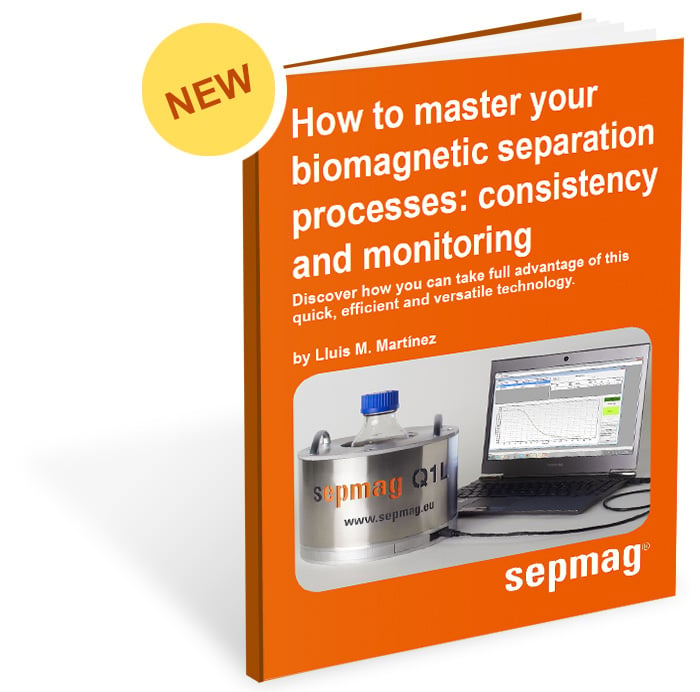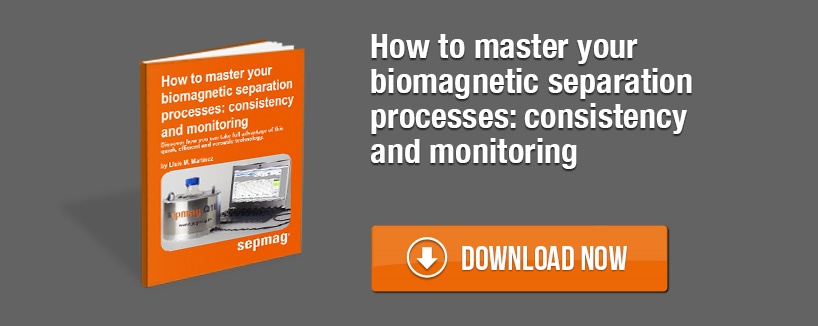Previously, the use of magnetic beads was limited to small volumes. The difficulty of scaling up beyond a few milliliters was misinterpreted as a limitation of the technology itself. However, as discussed in this e-book, the problem is not the biomagnetic separation process, but a lack of understanding of the physical processes governing it. Once you identify the key parameters that control the magnetic bead's behavior, it is easy to choose the right tools and methods to validate the process and replicate it at different volumes.The first and most important concept is that the key parameter for biomagnetic separation is the magnetic force, not the magnetic field. Permanent magnets attract beads, not because they generate an intense magnetic field, but because the magnetic field changes with the distance. The magnetic force over the beads is related to the space change of both the magnetic field and the beads’ magnetic moment.
The problem, and the source of the confusion, is that when using simple magnetic separators, the magnetic force decreases rapidly with distance. This reduction of magnetic force limits its reach and, consequently, the working volume. When working with large volumes, we need to generate a magnetic force that is constant over the entire working volume. Modern biomagnetic separation systems achieve this by simultaneously saturating the magnetic moment of the beads and applying a constant magnetic field gradient. This means all the magnetic beads in suspension move at the same speed, resulting in consistent separation regardless of the batch volume.
In addition, as the magnetic force is high enough to capture the farthest magnetic beads, you can avoid using excessive force in the retention zone. This means we can use gentler retention and avoid irreversible aggregation.
Using constant magnetic force separation also fosters a better understanding of how changes in the suspension composition affect your process. By monitoring the absorbance (using opacity) during separation, you can track optical changes. The suspension is initially homogeneous and dark but becomes transparent once all the magnetic beads have reached the retention areas. Because the magnetic force is constant, changes in the viscosity of the buffer can affect the separation time. The buffer's viscosity can be affected by variation in temperature or additives, or changes in the beads, e.g., due to changes in size, magnetic charge, or presence of aggregates. Such variation will translate into a different opacity/absorbance vs time curve.
Fitting this curve to a sigmoidal allows you to parameterize the process. This can be used for checking batch-to-batch consistency during production, but also for investigating the effects of suspension changes during product development. You can check how it affects the separation by adding PBS or TRIS, or comparing different magnetic beads and concentrations.
Once we have validated the magnetic force at a certain volume, we can use the values obtained as the basis for scaling up (or down) the process. The competition between the magnetic force and the drag force results in a constant separation speed. The separation time then simply scales up as the length of the distance the beads need to travel, which is usually the vessel radius or diameter.
As we have discussed in this e-book, by applying a constant magnetic force over the entire volume you guarantee a consistent biomagnetic separation process. With commercial equipment, you can even work with volumes up to 50 L.
Monitoring the process allows you to easily validate it. It also allows you to parameterize the effect that suspension changes have on the separation speed. These are two simple tools that will help you to master your biomagnetic separation process, regardless of your field of application.
The old saying ‘magnetic beads don’t work at large volumes’ is, simply, wrong. If you want to learn what leading IVD-manufacturers already know, this is the e-book for you!
Related news
- Different types of Immunoassays
- DBCO click chemistry: what is it and what are its benefits?
- What is poly dt?



